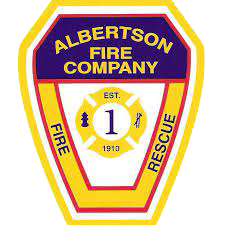Fire Extinguishers Safety
Not all fire extinguishers are the same. Each is designed for different materials based on the four basic classifications of fire. The Albertson Fire Department is pleased to provide this information as an aid to proper fire extinguisher selection for your home or office.
What are the four basic classifications of fire?
Class “A” fires are ordinary type combustibles, such as paper, wood, cloth, upholstery, plastics. These type fires can be extinguished with either a water type extinguisher or dry chemical type extinguisher.
Class “B” fires are fueled by combustible and flammable type liquids and gasses, such as cooking oils, grease, paint, motor oil, kerosene and gasoline. These type fires can be extinguished with either a dry chemical extinguisher or a carbon dioxide extinguisher. NEVER USE WATER.
Class “C” fires involve live electrical equipment or wires. These type fires can be extinguished by using a dry chemical extinguisher or a carbon dioxide extinguisher. By turning off the electric, the fire becomes a class “A” or “B” fire.
Class “D” fires involve combustible metals such as titanium, magnesium and zirconium. These fires need a special agent to extinguish them. The dry powder extinguisher is the agent that should be used to extinguish these fires.
How should I properly operate a fire extinguisher?
Please note that you should ALWAYS call the fire department to report the emergency before attempting to extinguish a fire. A fire extinguisher is not a substitute for the fire department. Fire grows and spreads quickly, and precious moments lost could result in significant damage or loss of life.
The proper method of using a fire extinguisher is based on the PASS system.
Pull the pin on the extinguisher
Aim the extinguisher at the base of the fire
Squeeze the handle together
Sweep the nozzle side to side
By remembering the acronym PASS you can remember the basics of using a fire extinguisher.
Don’t fight a fire unless:
You call the fire department first. The fire is small and not spreading.
You can get out fast, make sure you have an escape route first.
You know you have the correct extinguisher for the type of fire.
You know how to use the extinguisher. It’s too late to read the instructions when the fire is burning.
The Albertson Fire Department recommends that before you invest in an extinguisher, know what type you need. Contact the Fire Department or Nassau County Fire Marshal to discuss the types of fires you may require in your home or workplace. Make sure you periodically check your extinguisher and have it serviced when needed. Purchase an extinguisher that has a nationally accepted label, such as Underwriter’s Laboratories (UL) or Factory Mutual (FM)
